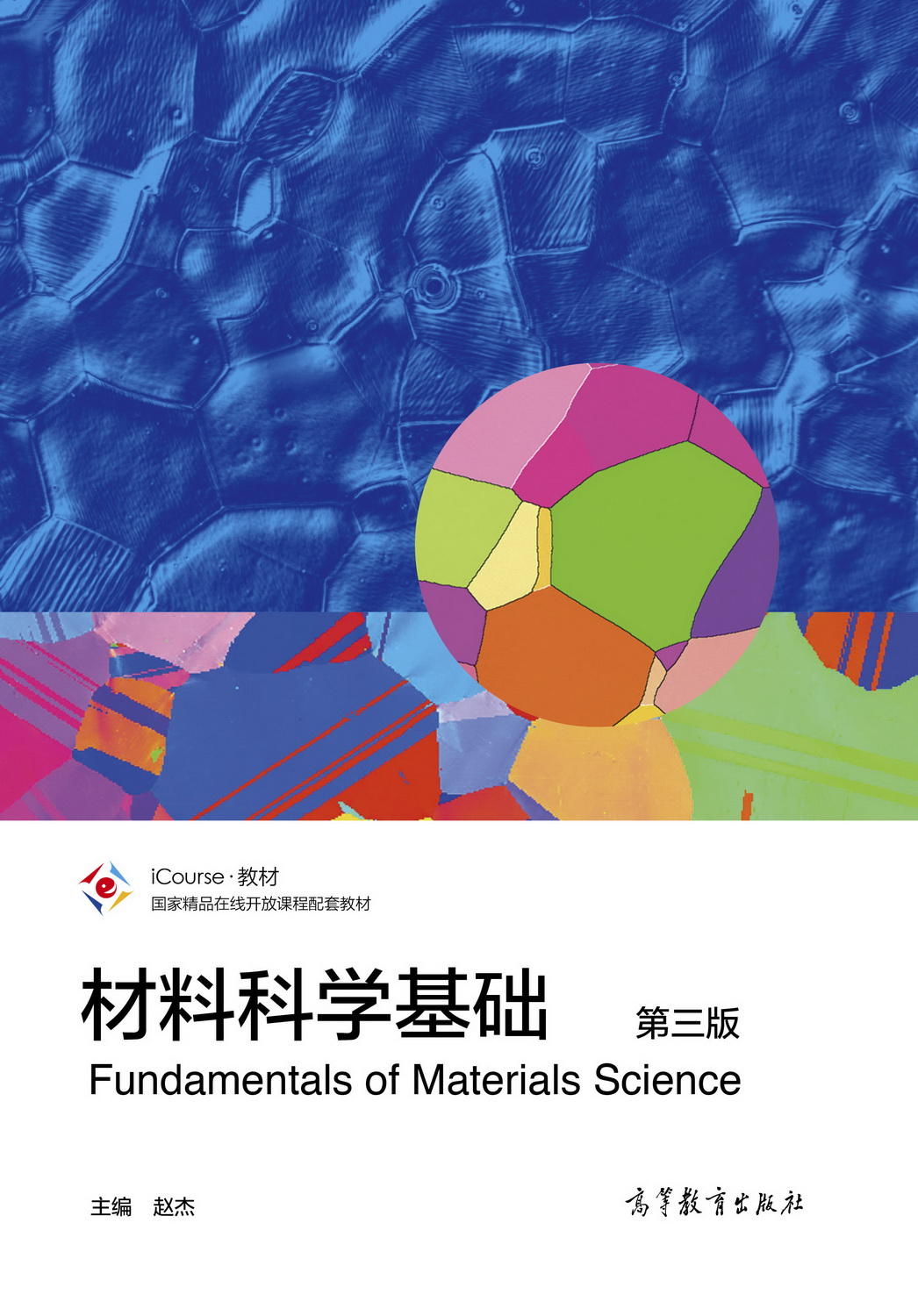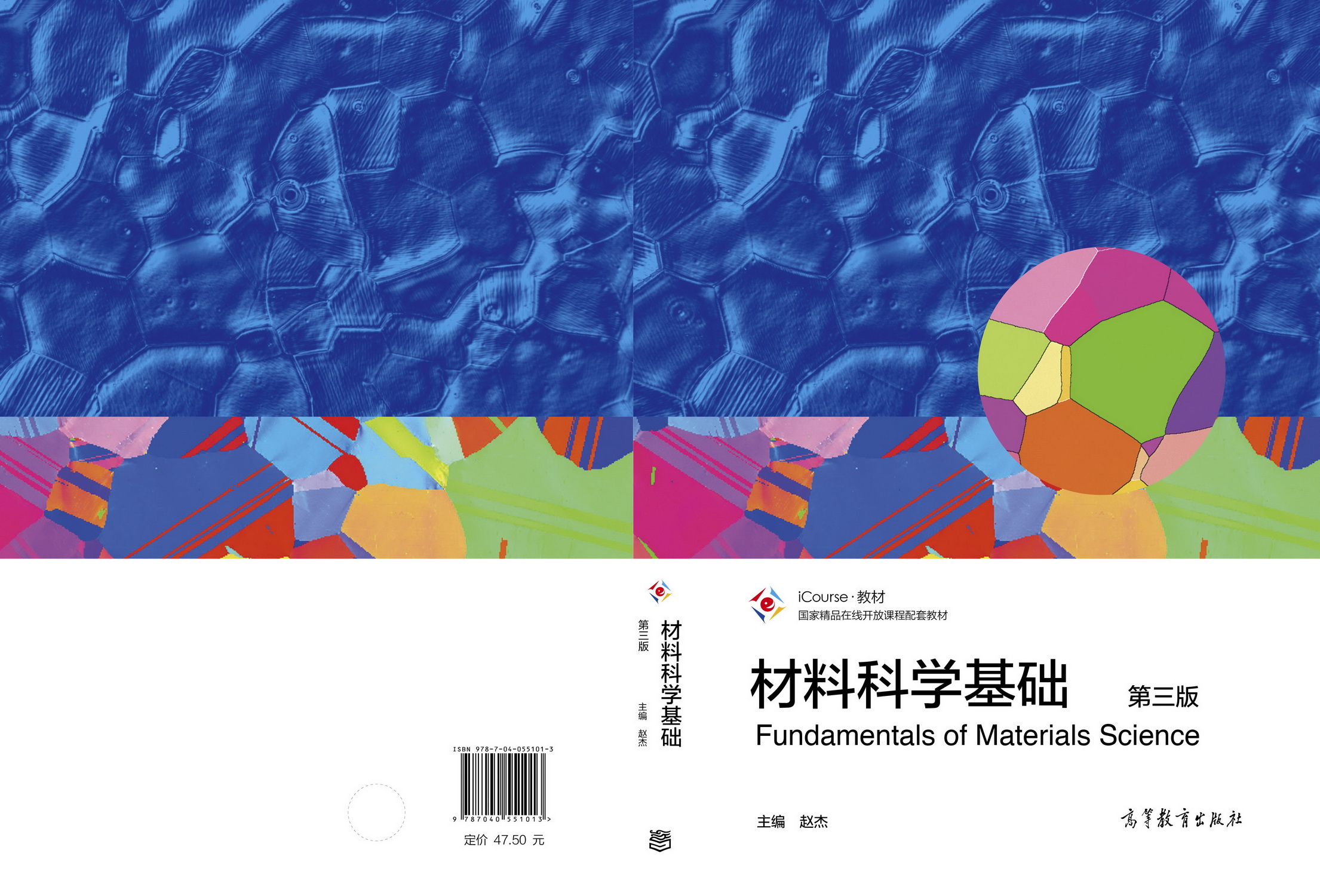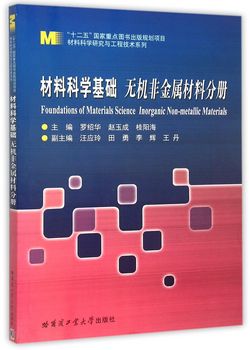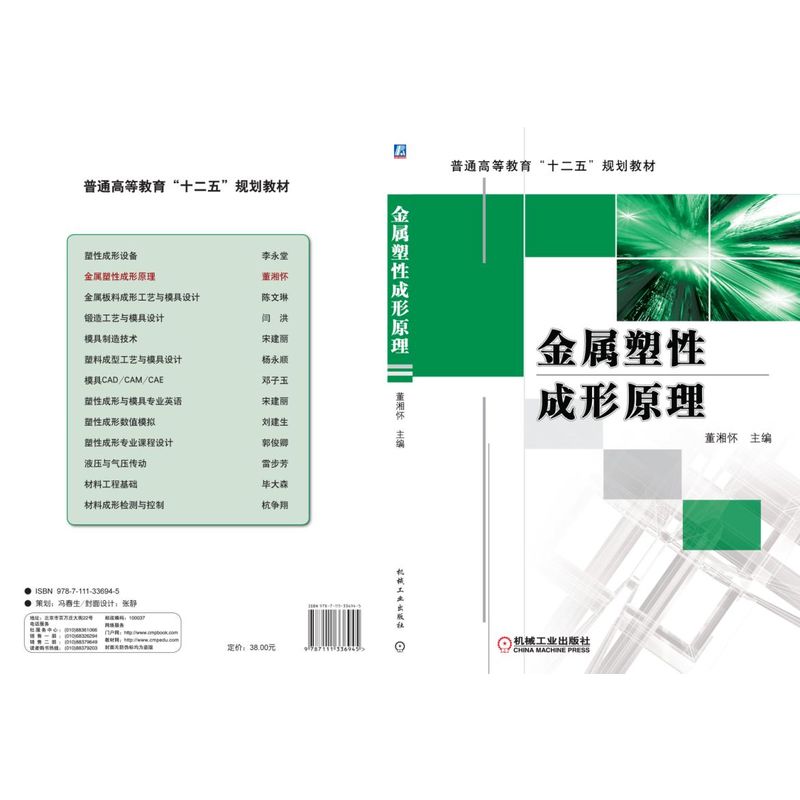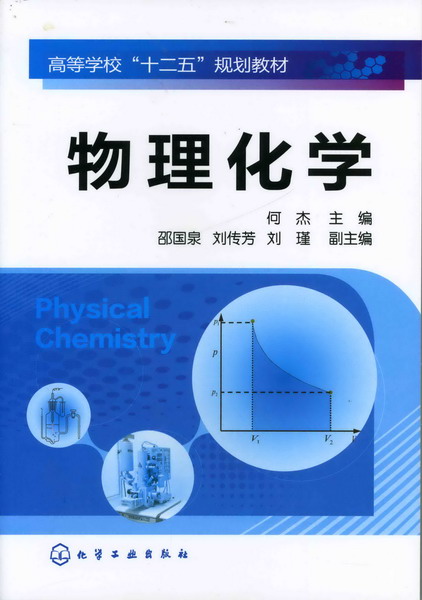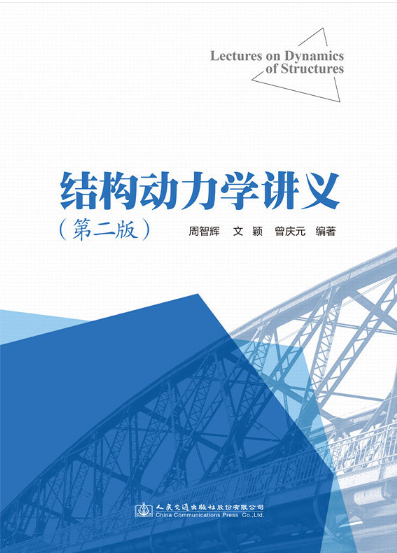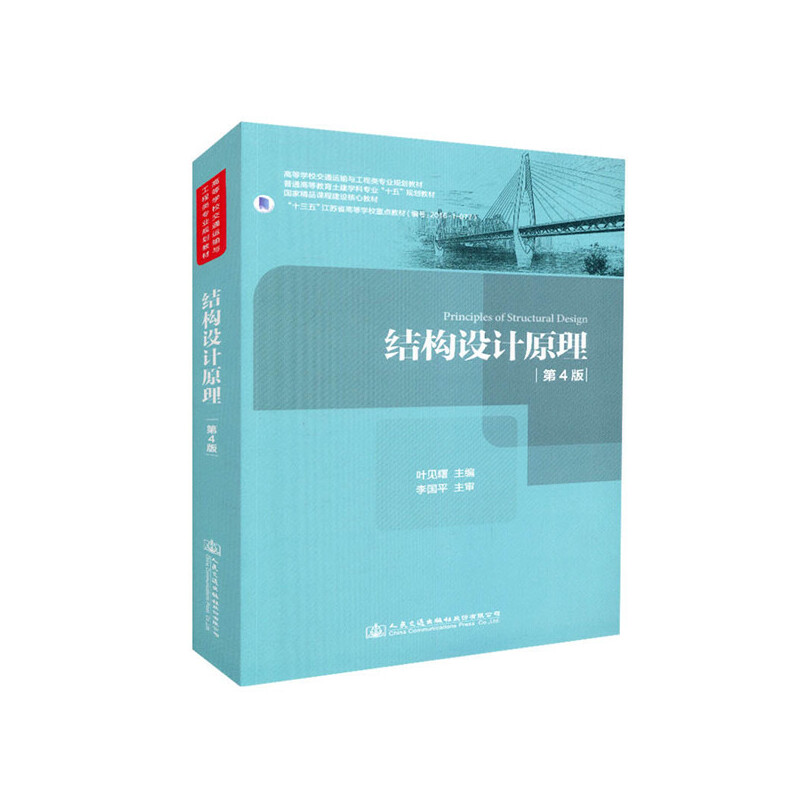材料科学基础(第3版)(配数字资源) / 国家精品在线开放课程配套教材
作者: 赵杰
出版时间:2021-07-16
出版社:高等教育出版社
- 高等教育出版社
- 9787040551013
- 3版
- 362076
- 48265037-1
- 平装
- 16开
- 2021-07-16
- 490
- 345
- 工学
- 材料类
- 材料类
- 本科
本教材是在大连理工大学出版社2015年出版的赵杰主编《材料科学基础》(第二版)的基础上,跟踪学科发展并总结近几年使用教材的反馈意见修订而成的。本教材是大连理工大学依托中国大学MOOC平台建设的国家精品在线开放课程——材料科学基础的配套教材,体现了编写团队近年来教学实践的相关成果。
材料科学是探究材料结构、制备、性能和使役行为之间关系和变化规律的一门应用基础学科。本教材将材料科学基础知识分为三个部分,即晶体学基础、形变及强化基础、相图及相变基础。主要内容包括原子结构与结合键、晶体结构、非晶体和准晶体结构、晶体缺陷、位错基础、材料的变形、回复再结晶、二元相图、三元相图、材料的凝固、固态扩散等。本教材结合计算机增强现实技术,针对较为抽象内容制作了动画、AR等相关模型,以促进学习者对相关知识点和原理的理解。为适应教育国际化的需要,本教材中提供了大部分专业词汇的英文名称,一些例题及材料科学重要人物介绍等采用英文形式。
本教材可作为高等学校本科材料类专业的教材,也可供研究生及相关人员选用。
前辅文
第一部分 晶体学基础
第1章 原子结构与结合键 Atomic Structure and Interatomic Bonding
1.1 原子结构 Atomic Structure
1.1.1 原子的内部结构 Inner Structures of Atoms
1.1.2 元素周期表The Periodic Table
1.1.3 原子电离能 Ionization Energy of an Atom
1.1.4 电子亲和能 Electron Affinity Energy
1.1.5 原子电负性 Electronegativity of an Atom
1.2 原子间的结合键 Interatomic Bonding
1.2.1 原子结合键的本质 Nature of Atomic Bonding
1.2.2 离子键 Ionic Bonding
1.2.3 共价键 Covalent Bonding
1.2.4 金属键 Metallic Bonding
1.2.5 范德瓦耳斯键 van der Waals Bonding
1.2.6 氢键 Hydrogen Bonding
第2章 晶体结构 Crystal Structures
2.1 晶体学基础Fundamental Concepts
2.1.1 空间点阵和晶胞Space Lattice and Unit Cell
2.1.2 晶向指数和晶面指数 Indices of Crystallographic Directions and planes
2.1.3 晶体投影Crystal Projection
2.2 纯金属的晶体结构Crystal Structures of Pure Metals
2.2.1 三种典型的金属晶体结构Three Typical Metallic Crystal Structures
2.2.2 点阵常数与原子半径Lattice Constant and Atomic Radius
2.2.3 晶体中原子堆垛方式与间隙Atomic Packing and Interstices
2.2.4 多晶型性Polymorphism
2.3 合金相的晶体结构Crystal Structures of Alloys
2.3.1 固溶体Solid solution
2.3.2 中间相 Intermediate Phases
2.4 离子晶体的结构Ionic Crystal Structures
2.4.1 离子晶体的结构规则Structure Rules of Ionic Crystals
2.4.2 典型离子晶体结构Typical Ionic Crystal Structures
2.5 共价晶体的结构Covalent Crystal Structures
第3章 非晶体和准晶体的结构 Amorphous and Quasicrystal Structures
3.1 非晶体的结构 Amorphous Structures
3.1.1 金属玻璃的形成Formations of Metallic Glasses
3.1.2 金属玻璃的结构Structures of Metallic Glasses
3.1.3 金属玻璃的性能 Properties of Metallic Glasses
3.2 准晶体的结构 Quasicrystal Structures
3.2.1 准晶体的结构 Quasicrystal Structures
3.2.2 准晶体的形成与性能 Formations and Properties of Quasicrystals
第4章 晶体缺陷 Crystal Defects
4.1 引言 Introduction
4.2 点缺陷Point Defects
4.2.1 金属中的点缺陷 Point Defects in Metals
*4.2.2 陶瓷中的点缺陷 Point Defects in Ceramics
*4.2.3 聚合物中的点缺陷 Point Defects in Polymers
4.3 原子振动 Atomic Vibration
4.4 位错Dislocation
4.4.1 位错的结构特征Structure of Dislocations
4.4.2 柏氏矢量 Burgers Vector
4.5 面缺陷 Planar Defects
4.5.1 外表面 Surface
4.5.2 晶界 Grain Boundary
4.5.3 孪晶界Twin Boundary
4.5.4 相界 Interface, Phase Boundary
4.5.5 其他面缺陷 Other Planar Defects
4.6 体缺陷 Bulk Defects
习题
第二部分 形变及强化基础
第5章 位错基础 Fundamentals of Dislocation
5.1 位错应力场Stress Field of Dislocation
5.1.1 刃型位错的应力场Stress Field of Edge Dislocation
5.1.2 螺型位错的应力场 Stress Field of Screw Dislocation
5.2 位错的能量及位错的线张力 Strain Energy and Line Tension of Dislocation
5.2.1 位错的能量 Dislocation Energy
5.2.2 位错的线张力Line Tension of Dislocation
5.3 位错的运动 Dislocation Movement
5.3.1 位错的滑移 Slip of Dislocation
5.3.2 位错的攀移 Climb of Dislocation
5.3.3 位错所受的力Force on Dislocation
5.3.4 位错的运动速度 Velocity of Dislocation Movement
5.4 位错间的相互作用 Interaction between Dislocations
5.4.1 平行位错间的弹性相互作用Elastic Interaction between Parallel Dislocations
5.4.2 相交位错间的相互作用Interaction between Crossing Dislocations
5.5 位错与点缺陷的相互作用Interaction between Dislocation and Point Defect
5.6 位错与表面的相互作用Interaction between Dislocation and Surface
5.7 位错的形成和增殖 Dislocation Formation and Multiplication
5.7.1 位错的形成 Dislocation Formation
5.7.2 位错增殖Dislocation Multiplication
5.8 实际晶体中的位错 Dislocation in Real Crystal
5.8.1 堆垛层错Stacking Fault
5.8.2 分位错Partial Dislocation
5.8.3 扩展位错 Extended Dislocation
第6章 材料的形变 Deformation of Materials
6.1 弹性变形 Elastic Deformation
6.2 塑性变形Plastic Deformation
6.2.1 滑移Slip
6.2.2 孪生Twinning
6.2.3 扭折Kink
6.3 多晶体的塑性变形Plastic Deformation of Polycrystalline
6.3.1 多晶体塑性变形行为 Plastic Deformation of Polycrystalline
6.3.2 晶粒尺寸的影响Effect of Grain Size
6.4 固溶体合金的塑性变形Plastic Deformation of Solid Solution Alloy
6.5 多相合金的塑性变形Plastic Deformation of Heterogeneous Alloy
6.5.1 复合型合金的塑性变形Plastic Deformation of Polyphase Alloy
6.5.2 弥散强化合金的塑性变形Plastic Deformation of Precipitation Strengthening Alloy
6.6 加工硬化Work Hardening
6.6.1 单晶体的加工硬化Work Hardening of Single Crystal
6.6.2 多晶体的加工硬化Work Hardening of Polycrystalline
6.7 屈服现象及应变时效Yielding and Strain Aging
6.7.1 屈服现象Yielding
6.7.2 应变时效 Strain Aging
6.8 塑性变形中材料组织与性能的变化Evolution of Microstructure and Property during Plastic Deformation
6.8.1 晶粒组织变化Development of Grains
6.8.2 位错亚结构的变化Development of Substructure
6.8.3 形变织构Deformation Texture
6.8.4 残余应力Residual Stress
第7章 回复与再结晶 Recovery and Recrystallization
7.1 概述Introduction
7.1.1 组织的变化Microstructural Evolution
7.1.2 性能的变化Property Evolution
7.2 回复Recovery
7.2.1 回复动力学Recovery Kinetics
7.2.2 回复机理Recovery Mechanism
7.2.3 回复的应用Application of Recovery Process
7.3 再结晶Recrystallization
7.3.1 再结晶的形核及长大Nucleation and Growth during Recrystallization
7.3.2 再结晶动力学Recrystallization Kinetics
7.3.3 再结晶温度Recrystallization Temperature
7.3.4 再结晶结束的晶粒尺寸Grain Size after Recrystallization
7.4 晶粒长大Grain Growth
7.4.1 正常晶粒长大Normal Grain Growth
7.4.2 异常晶粒长大Abnormal Grain Growth
7.4.3 再结晶图Recrystallization Diagram
7.4.4 再结晶织构与退火孪晶 Recrystallization Texture and Annealing Twin
7.5 动态回复和再结晶Dynamic Recovery and Recrystallization
7.5.1 动态回复Dynamic Recovery
7.5.2 动态再结晶Dynamic Recrystallization
7.5.3 热加工引起的组织与性能的变化Evolution of Microstructures and Properties
7.5.4 蠕变Creep
7.5.5 超塑性Superplasticity
习题
第三部分 相图及相变基础
第8章 二元相图 Binary Phase Diagrams
8.1 相图基础知识 Fundamental Concepts of Phase Diagrams
8.1.1 相平衡与相律 Phase Equilibrium and Phase Rule
8.1.2 相图Phase Diagrams
8.1.3 相图的试验测定方法 Measurement for Phase Diagrams
8.1.4 杠杆定律 Lever Rule
8.2 相图的热力学基础 Thermodynamics of Phase Diagrams
8.2.1 固溶体的自由能—成分曲线 Free Energy-Composition Curve of Solid Solution
8.2.2 多相平衡的公切线原理 Common Tangent Line for Multi-Phase Equilibrium
8.2.3 从自由能—成分曲线推测相图 Prediction of Phase Diagrams based on Free Energy-Composition Curve
8.2.4 二元相图的几何规律 Geometric Principles of Phase Diagrams
8.3 二元相图 Binary Phase Diagrams
8.3.1 匀晶相图Isomorphous Phase Diagrams
8.3.2 共晶相图Eutectic Diagrams
8.3.3 包晶相图 Peritectic Phase Diagrams
8.3.4 复杂二元相图的分析方法 Analysis for Complex Binary Diagrams
8.4 二元相图分析实例——铁碳相图 The Iron-Iron Carbide Phase Diagram
8.4.1 铁碳二元合金中的相 The Phases in Fe-C Binary Alloy
8.4.2 铁碳相图The Iron-Iron Carbide Phase Diagram
8.5 相图的应用 Applications of Phase Diagrams
第9章 三元相图 Ternary Phase Diagrams
9.1 三元相图基础 Fundamentals for Ternary Phase Diagrams
9.1.1 三元相图的特点 Characteristics of Ternary Phase Diagrams
9.1.2 三元相图成分表示方法 Plotting Compositions on a Ternary Phase Diagrams
9.1.3 杠杆定律及重心定律 Lever Rule and Gravity-Center Rule
9.2 三元匀晶相图 Ternary Isomorphous Phase Diagrams
9.2.1 相图分析Analysis on Phase Diagrams
9.2.2 固溶体的凝固过程 Solidification of Ternary Solid Solution
9.3 三元共晶相图 Ternary Eutectic Phase Diagrams
9.3.1 组元在固态完全不溶 Negligible Solubilities of the Components
9.3.2 组元在固态有限溶解 Limited Solubilities of the Components
9.4 三元包晶相图Ternary Peritectic Phase Diagrams
9.5 三元相图的分析方法 Specification of Ternary Phase Diagrams
9.6 三元相图举例 Examples of Typical Ternary Phase Diagrams
第10章 材料的凝固 Solidification of Materials
10.1 材料凝固的基本规律Basic Rules of Solidification
10.1.1 液相结构 Structure of Liquid
10.1.2 凝固的热力学条件 Thermodynamics of Solidification
10.1.3 结晶的一般规律 General Rule of Crystallization
*10.1.4 金属玻璃 Metallic Glasses
10.2 凝固时的形核 Nucleation of Crystals
10.2.1 均匀形核 Homogeneous Nucleation
10.2.2 非均匀形核 Heterogeneous Nucleation
10.3 晶体的长大 Growth of Crystals from Liquid Phase
10.3.1 晶体生长的动态过冷度 Dynamic Supercooling
10.3.2 固液界面结构 The Nature of the Solid-Liquid Interface
10.3.3 液体中的温度分布及晶体生长方式 Temperature Distribution and Crystal Growth
10.4 固溶体的凝固 Solidification of Solid Solution
10.4.1 固溶体结晶特点 Crystallization in Solid Solution
10.4.2 固溶体的平衡凝固 Equilibrium Freezing in Solid Solution
10.4.3 固溶体的非平衡凝固 Non-Equilibrium Freezing in Solid Solution
10.4.4 区域熔炼 Zone Melting or Zone Refining
10.4.5 成分过冷 Constitutional Supercooling
10.5 共晶体的凝固 Eutectic Freezing
10.5.1 共晶体的形成 Formation of Eutectic Alloy
10.5.2 共晶体的分类及形态 Types of Eutectic Structures
10.6 铸锭组织 Microstructure of Casting Ingot
10.6.1 铸锭的典型组织 Typical Structure of Casting Ingot
10.6.2 铸锭组织的控制 Control of Microstructure in Casting Ingot
10.6.3 铸锭的缺陷 Defects in Casting Ingot
第11章 固态扩散 Solid Diffusion
11.1 扩散现象 Diffusion Phenomena
11.2 扩散定律 Diffusion Laws
11.2.1 菲克第一定律 Ficks First Law
11.2.2 菲克第二定律 Ficks Second Law
11.3 扩散定律的应用 Applications of Diffusion Laws
11.3.1 稳态扩散 Steady-State Diffusion
11.3.2 非稳态扩散 Nonsteady-State Diffusion
11.3.3 扩散系数的测定 Measurement of Diffusion Coefficient
11.4 扩散机理和微观理论Diffusion Mechanisms and Theory
11.4.1 置换型固溶体扩散机制Diffusion Mechanisms in Substitutional Solid Solution
11.4.2 间隙固溶体扩散机制Diffusion Mechanisms in Interstitial Solid Solution
11.4.3 原子跳跃与扩散系数 Atom Jump and Diffusion Coefficient
11.4.4 扩散系数与扩散激活能 Diffusion Coefficient and Activation Energy
11.4.5 无规则行走和扩散距离 Random Walk and Diffusion Distance
11.5 柯肯达尔效应和达肯方程 Kirkendall Effect and Darken Equation
11.5.1 柯肯达尔效应 Kirkendall Effect
11.5.2 达肯方程 Darken E与正文是对应的,但跟上一个标题有出入quation
11.6 扩散的热力学分析 Thermodynamics of Diffusion
11.7 反应扩散 Reaction Diffusion
11.8 扩散的影响因素 Influence Factors of Diffusion
11.8.1 温度 Temperature
11.8.2 晶体结构 Crystal Structures
11.8.3 晶体缺陷 Crystal Defects
11.8.4 化学成分 Chemical Composition
11.8.5 外场 External Fields
习题
附录1 元素周期表
附录2 元素的电负性
附录3 原子和离子半径
专业词汇中英文对照表
参考文献

